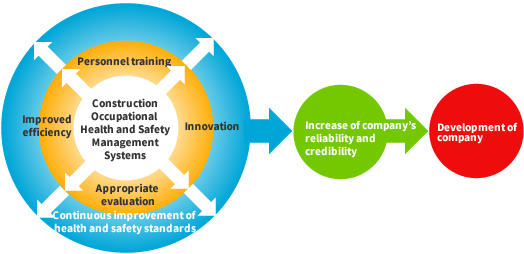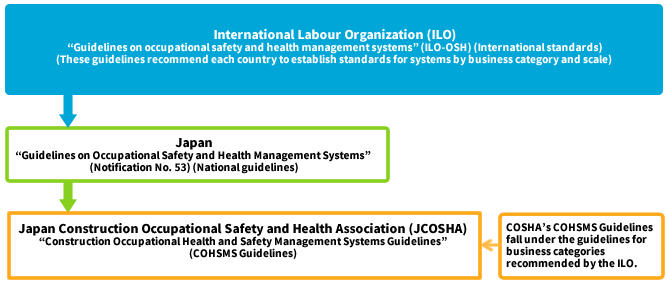About COHSMS
Nowadays any responsible organization needs to put in place occupational health and safety management systems and use them systematically as a management tool. The independent preparation of such a system for a business, followed by its secure and effective implementation leads to an array of positive effects, such as the elimination and reduction of potential business disaster risks; the improvement of worker health and creation of comfortable working conditions; and the enhancement of corporate occupational safety and health standards.
Based on this understanding, the Ministry of Health, Labour and Welfare released the Guidelines on Occupational Safety and Health Management Systems (Notification No. 53) in April 1999.
Taking into account the characteristics of the construction industry (where businesses carry out their work on a temporary, fixed term project basis and principal contractors and their subcontractors cooperate with each other in preventing occupational accidents), JCOSHA published the Construction Occupational Health and Safety Management Systems (COHSMS) Guidelines in November 1999 (revised in June 2006) in accordance with the above-mentioned Ministry of Health, Labour and Welfare's guidelines. In addition, to promote and disseminate the COHSMS Guidelines among construction companies and improve occupational health and safety standards throughout the construction sector, JCOSHA is engaged in the following activities.
Construction Occupational Health and Safety Management System
Purpose of COHSMS and benefits of introducing the system
The purpose of COHSMS is to establish a framework within which construction businesses and their employees work together, and principal contractors and their subcontractors cooperate with each other to implement the following initiatives: operate Plan-Do-Check-Act (PDCA) cycles to eliminate potentially dangerous and harmful factors concerning industrial accidents occurring in work sites; improve worker health and create comfortable working conditions; and enhance the health and safety standards of construction companies.
By introducing this system, the following benefits can be expected.
- Incorporating the concept of health and safety in their management philosophy makes a clear statement that health and safety management is indispensable in the conduct of daily work.
- The operation of PDCA cycles ensures continuous and incremental improvement of health and safety standards
- The introduction of risk assessment enables the establishment of health and safety measures appropriate to the conditions of each construction site
- Participation by workers and other staff members stimulates health and safety initiatives and activities.
- Without solely relying on individual limited abilities, larger organizational initiatives are made possible.

International status of COHSMS
In June 2001, the International Labour Organization (ILO) established guidelines on occupational safety and health management systems (ILO-OSH-2001) as the sole international standards. These standards stipulate that each country may establish guidelines for occupational safety and health management systems in accordance with different business categories and the scale of an enterprise.
The diagram below explains this relationship.
Based on the internationally-accepted COHSMS Guidelines, construction companies are expected to create, implement, and operate such systems.

About COHSMS Guidelines
Taking into account the special characteristics of the construction industry, the COHSMS Guidelines designate the type of health and safety management system required. They are based on the Guidelines on Occupational Safety and Health Management Systems announced by the Minister of Health, Labour, and Welfare. Employers in the construction industry should on their own initiatives voluntarily adopt these management systems. For details, please refer to:
About COHSMS GuidelinesPromotion of COHSMS
To further the aims of COHSMS, we are committed to the following initiatives.
Textbooks
- Key Points of the Construction Occupational Health and Safety Management Systems (COHSMS) Guidelines
- Construction Occupational Health and Safety Management Systems (COHSMS) Guidelines--How to Conduct a System Audit
- Construction Occupational Health and Safety Management Systems (COHSMS) Guidelines Manual
- Others (reference materials for the "Identification of Risks and Hazards")
Training Courses and Seminars
- Training course for planners of COHSMS to acquire basic knowledge about establishing COHSMS are held at the Construction Occupational Safety and Health Training Center.
- Training courses for the promotion and dissemination of COHSMS are also held. Their subjects vary according to the needs and situation of the construction industry in a region.
Support Service
In order to meet the needs of those construction companies wishing to establish a system based on the COHSMS Guidelines, we send out experts to first consult with a company and then offer expert advice and support internal system audits.
Research and Survey Activities
To better promote and disseminate COHSMS, we gather information on Occupational Health and Safety Management Systems both in Japan and abroad. We also conduct researches related to COHSMS, such as developing methods to identify risks and hazards.